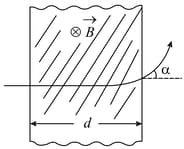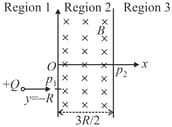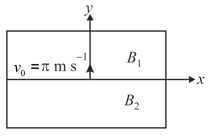Mention the different fields used in the velocity selector.
Important Questions on Moving Charges and Magnetism
A velocity selector consists of electric field and magnetic field with . The value required for an electron of energy moving along the positive -axis to pass undeflected is
(Given, mass of electron )
A proton (mass ) accelerated by a potential difference flies through a uniform transverse magnetic field . The field occupies a region of space by width . If be the angle of deviation of proton from the initial direction of motion (see figure), the value of will be:

| Column 1 | Column 2 | Column 3 |
| 1. Electron with | (i) | (P) |
| 2. Electron with | (ii) | (Q) |
| 3.Proton with | (iii) | (R) |
| 4. Proton with | (iv) | (S) |
At a place, an electric field and a magnetic field are in the downward direction. There an electron moves in the downward direction. Hence this electron.____________.
In a region, an electric field and a magnetic field of are applied. A beam of positively charged particles is projected along X-direction. Find the velocity of particles that move undeflected in these crossed fields.
| Column 1 | Column 2 | Column 3 |
| 1. Electron with | (i) | (P) |
| 2. Electron with | (ii) | (Q) |
| 3.Proton with | (iii) | (R) |
| 4. Proton with | (iv) | (S) |
In which case would the particle move in a straight line along the negative direction of y axis

| Column 1 | Column 2 | Column 3 |
| 1. Electron with | (i) | (P) |
| 2. Electron with | (ii) | (Q) |
| 3.Proton with | (iii) | (R) |
| 4. Proton with | (iv) | (S) |
In which case will the particle describe a helical path with axis along positive z direction?


